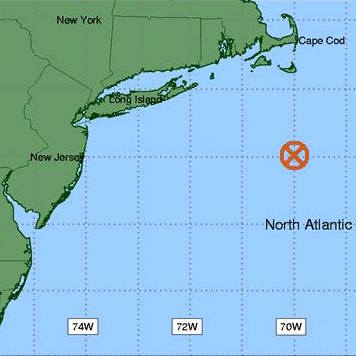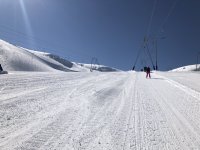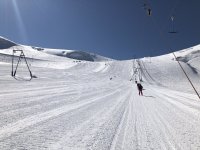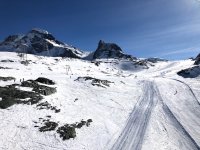Iconic Horstman T-Bar Removed Due to Glacier Melt
The Whistler Blackcomb T-Bar was a fixture in a golden era of summer skiing and films
When Level 1 posted a tribute to Whistler Blackcomb’s iconic Horstman T-Bar on July 13, skiers mourned for one of their own. Since its installation in 1987, the surface lift served the public park, was a fixture in the summer ski scene, and scores of incredible skiers cut their teeth on that part of the glacier.
“It’s where so much of the sport as we know it today really developed,” said Level 1’s Josh Berman. “When you’ve got the best skiers in the world gathered in one place with blue skies, soft snow, and a competitive atmosphere, you’re going to see some amazing things.”
Though the Horstman T-Bar was removed this week due to longstanding glacier melt issues, it’s important to note that summer skiing on the Horstman Glacier is not over. A spokesperson at Whistler Blackcomb told POWDER, “Over time, the Horstman Glacier’s profile has changed to the point that the Horstman T-bar became inoperable and required us to remove it. The Showcase T-bar is in a better location and will continue to service the glacier for both summer and winter. We are looking forward to welcoming skiers and riders for the winter season, several months away, and our intent is to be back to summer glacier skiing in 2021.”
Momentum Camps now uses the Showcase T-Bar to access their terrain—taken in 2016.
Made famous in Johnny Decesare’s Poor Boyz Productions films like “State of Mind” and “Degenerates,” the Horstman T-Bar was home to skiers including JP Auclair, Mike Douglas, Vincent Dorian, and J.F. Cusson, who made a name for themselves and the New Canadian Air Force, pushing the limits of freestyle skiing on the slushy summer snow of the Horstman glacier—against the wishes of the snowboarder-dominant park scene. The legacy of skiing and filmmaking on that glacier lives on through Level 1 films. Half of their first film, “Balance,” was shot there by Berman and Jeff Winterton while they crashed on Sarah Burke’s couch.
When asked whether the other side of the Horstman glacier or other glaciers in the US and Europe could serve the same function as the T-Bar, Berman replied, “I don’t know if the legacy of the golden era we’re referring to can really be picked up and put anywhere else. But summer skiing will hopefully maintain space in the sport as a gathering point for aspiring pros and older mentors. As soon as the snow melts and there are fewer far-flung places to ski, people come to where there’s snow.”
That’s what makes places like Horstman so special—the scarcity of summer snow concentrates skiers who usually never meet in the winter months. These sites become a place to share ideas and push new boundaries.
Ski camps such as Ken Achenbach’s no-longer-running Camp of Champions, which was among the first terrain parks to allow skiers, and John Smart’s Momentum Ski Camps utilized the glacier to train new athletes and push the sport forward.
Smart, a 13-time World Cup medalist, and two-time Olympian stated that though the Horstman T-Bar is gone, Blackcomb will still be a hub of summer skiing for years to come. “The majority of the melt out on the glacier has been on the Horstman T-Bar. Over the years that area has gotten to be too much work to maintain. One of the best solutions we found with the mountain was using the existing chairlifts. Our camps relied on the Horstman T-Bar, but we now have a new route through the Glacier Express chair and then access the glacier through a single chair lift.”
The footprint on the glacier will be smaller now, and less hassle for the mountain ops. Smart’s hope is that the resort will move the existing snowmaking equipment from the Horstman T-Bar area and bring it to the Showcase area, to further improve the snow farming on that side. The future of the glacier will be with the camps; there is no public skiing on the Showcase side of the glacier.
“Climate change and the way it affects our sport really makes me sad. I wouldn’t have imagined I’d see the changes affecting our sport so deeply over the course of my career,” Berman said. “We’re seeing its effects much more quickly and impactfully than we’d imagined. I hope it wakes people up to the fact that this is real and I hope that people will be inspired to make personal changes and lobby for changes beyond their control to preserve our sport for future generations. My dad’s generation never thought to ask ‘What does skiing look like in 20 years?’ But I’m asking that for my kids.”



